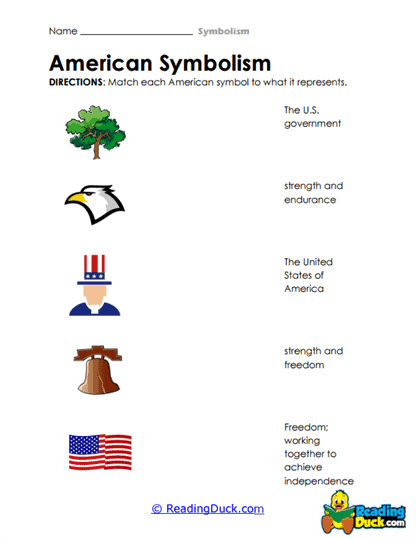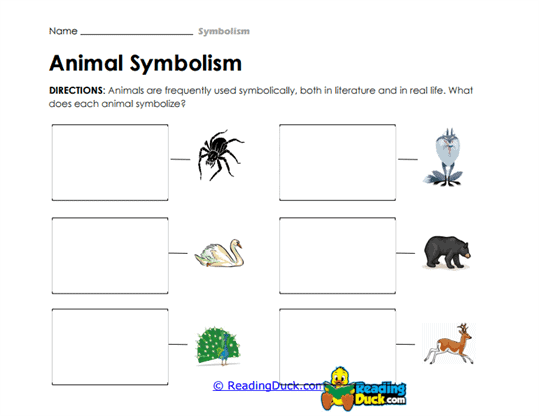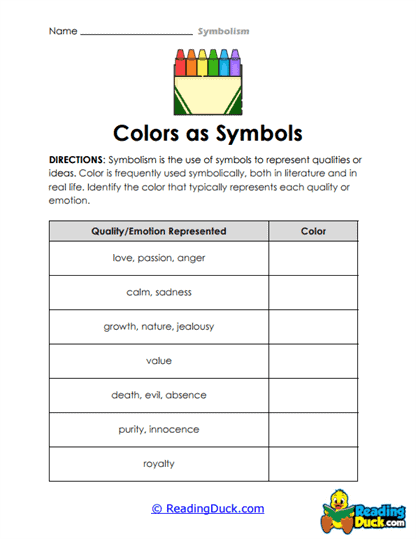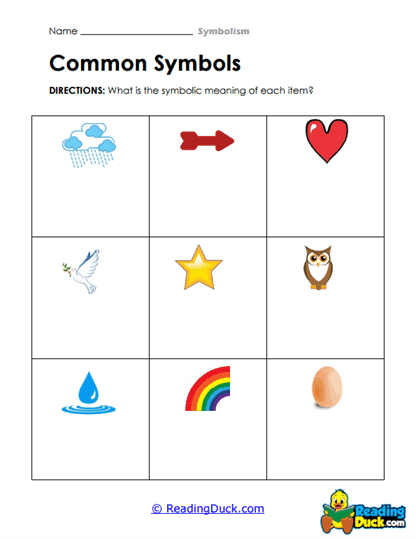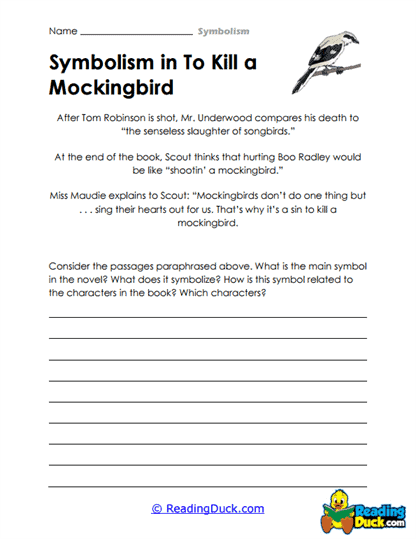Symbolism Worksheets
About Our Symbolism Worksheets
This collection of Symbolism Worksheets falls under the Language category within the Skills section, providing students with a structured approach to understanding and mastering the use of symbolism in literature and other forms of communication. Symbolism is an important literary device that allows writers to imbue objects, characters, or events with deeper meanings, enhancing both creative expression and comprehension. Through this collection, students will be able to interpret symbolic meanings and apply them in their reading and writing, thus expanding their language abilities and critical thinking skills.
The worksheets are presented in PDF format, making them simple to view, download, and print. Each worksheet also includes a downloadable answer key, making it easier for educators and parents to guide students through the material. Whether in a classroom or homeschool setting, these worksheets offer students engaging opportunities to explore symbolism in a variety of contexts, improving their overall language proficiency.
What is Symbolism? Understanding the Power of Hidden Meaning
Symbolism is a powerful tool in language and literature, used by writers to convey deeper meanings beyond the literal level. Symbols are objects, characters, or actions that represent abstract ideas, emotions, or themes. Learning how to recognize and interpret symbolism enables students to engage more deeply with texts, fostering a richer understanding of both the content and the author’s intent.
Defining Symbolism
Symbolism occurs when an object, character, or event represents something beyond its literal meaning, often embodying larger themes or ideas. These symbols are used by writers to express complex emotions, cultural ideas, or social concepts that may not be explicitly stated in the text.
- Basic Concept: A symbol is a tangible object or action that represents an intangible idea. For example, a rose may symbolize love or beauty, while a storm might represent conflict or change.
- Symbols vs. Literal Meanings: While every object has a literal meaning, a symbol carries an additional, often abstract, meaning. Recognizing the symbolic value in literature helps students move beyond the surface level and understand the thematic depth of a story. For instance, in literature, a road could literally be a path to travel, but symbolically, it may represent life's journey, decisions, or challenges.
Common Types of Symbols
In literature, symbolism can take many forms, and understanding these different types helps students become more adept at recognizing and interpreting symbols in their reading.
Objects: Physical objects are commonly used as symbols in literature. For example:
-
- Light often symbolizes knowledge or purity.
- Darkness can symbolize ignorance or evil.
Characters: Sometimes, characters themselves are symbolic, representing broader ideas or qualities. For example:
-
- A hero may symbolize courage, hope, or justice.
- A trickster might represent chaos, disruption, or transformation.
Colors: Colors are frequently used as symbols to represent emotions, moods, or themes:
-
- Red may symbolize love, passion, or danger.
- White often symbolizes purity, innocence, or peace.
Actions or Events: Certain actions or events in a narrative may carry symbolic meaning. For instance:
-
- A character crossing a bridge might symbolize a major life transition or a new beginning.
- A season change from winter to spring could symbolize renewal or the passage of time.
Understanding these categories of symbolism enables students to approach texts with a more analytical mindset, identifying deeper layers of meaning that enrich their reading experience.
Different Usages of Symbolism in Literature and Beyond
Symbolism is not limited to literature alone. It appears in various forms of communication, including art, film, advertising, and everyday language. Exploring these different usages helps students understand the wide-reaching importance of symbolism in both artistic and practical contexts.
Symbolism in Literature
Writers frequently use symbols to reinforce themes, express emotions, or convey underlying messages that are not explicitly stated in the text.
- Example: In F. Scott Fitzgerald’s The Great Gatsby, the green light at the end of Daisy’s dock is a powerful symbol of Gatsby’s unattainable dreams and the elusive nature of the American Dream.
- Example: In Nathaniel Hawthorne’s The Scarlet Letter, the scarlet letter “A” that Hester Prynne wears is a symbol of shame and sin, but as the story progresses, it also becomes a symbol of strength and resilience.
Symbolism in Art
In visual art, symbols are often used to communicate ideas or emotions that go beyond the visual elements themselves. Colors, shapes, and objects in a painting or sculpture can carry symbolic significance.
- Example: In Pablo Picasso’s Guernica, the broken sword symbolizes the destruction and futility of war, while the figure of the horse represents the suffering of innocents.
Symbolism in Advertising
In advertising, companies use symbols to create emotional connections with their audience and convey messages about their brand in subtle ways.
- Example: The apple in Apple’s logo symbolizes knowledge and innovation, playing on the historical connotation of the apple from the biblical story of Adam and Eve, but in a modern and positive context.
Symbolism in Everyday Language
In everyday conversation, we often use symbols to express ideas in a concise, impactful way.
- Example: Common idioms like “walking a tightrope” can symbolize being in a precarious situation, even though the literal act of tightrope walking isn’t involved.
By learning how symbolism works in different mediums, students can begin to see how this device operates in all forms of communication, enhancing both their analytical and creative thinking skills.
The Impact of Symbolism on Literacy Development
Understanding symbolism plays a crucial role in students’ literacy development. It not only improves their comprehension of literary texts but also enhances their ability to interpret, analyze, and express complex ideas in both reading and writing.
Enhancing Reading Comprehension
Recognizing symbols in literature deepens students’ understanding of texts by allowing them to perceive the underlying themes and emotions that an author conveys. Students who can interpret symbolism are better equipped to appreciate the richness of a text and engage with its deeper meaning.
- Example: When reading William Golding’s Lord of the Flies, understanding that the conch shell symbolizes order and civilization helps students grasp the larger thematic message about the fragility of societal rules.
Improving Writing Skills
Using symbolism in writing enables students to convey ideas with greater depth and nuance. When students learn to incorporate symbols into their creative writing, they can communicate complex emotions or themes more effectively, making their work more engaging and sophisticated.
- Example: A student writing a short story might use a setting sun as a symbol of closure or the end of a phase in the protagonist’s life, adding emotional weight to their narrative without stating it explicitly.
Boosting Speaking and Listening Skills
In discussions about literature, film, or art, the ability to recognize and analyze symbolism enhances students’ speaking and listening skills. By interpreting symbols and discussing their meanings, students learn to articulate complex ideas and listen attentively to the interpretations of others.
By fostering these skills, symbolism helps students become more thoughtful and fluent readers, writers, and speakers.
Interactive Activities to Reinforce Symbolism Learning
To reinforce students’ understanding of symbolism, educators can introduce various engaging and interactive activities. These activities can be adapted for both in-class and homeschool settings, and they cater to different grade levels to ensure a comprehensive learning experience.
Suggested Activities for Younger Students (Grades 3-5)
- Symbol Hunt: Encourage students to search for symbols in their favorite books, movies, or even around the classroom. They can then share their findings and explain what each symbol represents. This activity builds students’ ability to recognize and interpret symbols in different contexts.
Activities for Middle School Students (Grades 6-8)
- Symbolism Storytelling: Have students create short stories using one or two key symbols to convey a deeper meaning. For example, they could use a tree to symbolize growth or a broken mirror to symbolize change. This task encourages creative writing and the application of symbolism in their own narratives.
Activities for High School Students (Grades 9-12)
- Literary Analysis Presentations: Assign students a piece of literature with strong symbolic elements and have them present their analysis of the text’s symbolism to the class. This helps them develop critical thinking and presentation skills while deepening their understanding of symbolism in literature.
These activities not only reinforce students’ knowledge of symbolism but also make the learning process more interactive and enjoyable, ensuring that they grasp the concept in a meaningful way.
The Practical Importance of Symbolism in Everyday Life
Symbolism is not only a literary device but also a critical skill for interpreting and communicating complex ideas in everyday life. The ability to understand and use symbols enhances students’ cognitive and creative abilities, preparing them for real-world applications in various fields, from literature and art to marketing and communication.
In professional and personal contexts, recognizing symbolism helps individuals navigate deeper meanings in conversations, media, and social interactions. For example, symbols are frequently used in speeches, films, and advertisements to evoke emotions or convey important messages, and those who can interpret these symbols are better equipped to understand the full scope of the communication.
In conclusion, this collection of Symbolism Worksheets offers students a thorough and engaging approach to understanding one of the most important devices in language and literature. By learning to interpret and use symbolism, students enhance their critical thinking, literacy, and creative expression, equipping them with the skills they need to succeed in both academic and real-world environments.
